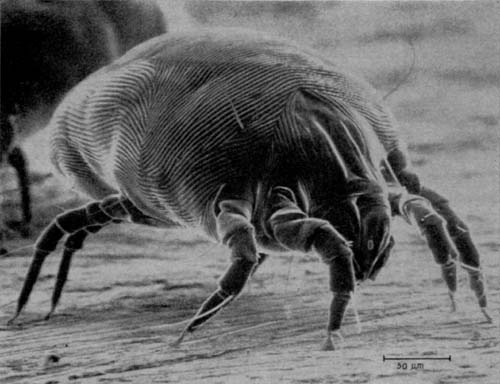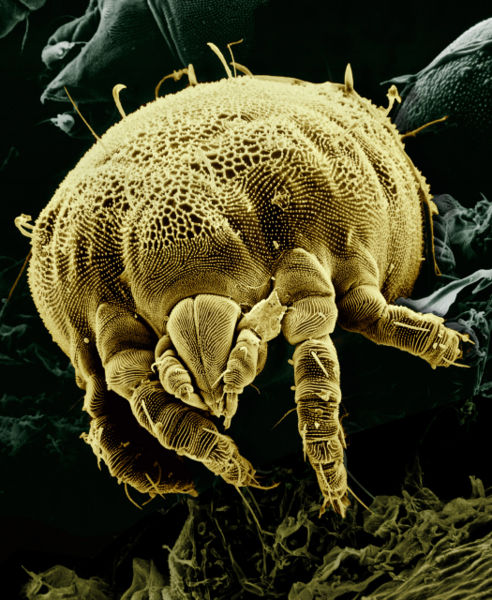Mite
Mites, along with ticks, belong to the subclass Acarina (also known as Acari) and the class Arachnida. Mites are among the most diverse and successful of all the invertebrate groups. They have exploited an incredible array of habitats, and because of their small size (most are microscopic) most go totally unnoticed. Many live freely in the soil or water, but there are also a large number of species that live as parasites on plants or animals and even some that feed on mold.
Some of the plant pests include the so called spider mites (family Tetranychidae), thread-footed mites (family Tarsonemidae), and the gall mites (family Eriophyidae). Among the species that attack animals are members of the Sarcoptic Mange mites (family Sarcoptidae), which burrow under the skin. Demodex mites (family Demodicidae) are parasites that live in or near the hair follicles of mammals, including humans. Perhaps the best-known mite, though, is the house dust mite (family Pyroglyphidae).
Insects may also have parasitic mites. Examples are Varroa destructor which attaches to the body of the honeybee, and Acarapis woodi (family Tarsonemidae), which lives in the tracheae of honey bees. There are hundreds of species of mites associated with other bee species, and most are poorly described and understood. Some are thought to be parasites, while others beneficial symbionts.
There are over 45,000 described species of mites[1]. Scientists believe that we have only found 5% of the total diversity of mites. Mites are believed to have existed for around 400 million years.
The scientific discipline devoted to the study of ticks and mites is called acarology.
The tropical species Archegozetes longisetosus is one of the strongest animals in the world, relative to its mass (100 μg): It lifts up to 1182 times its own weight, over five times more than would be expected of such a minute animal (Heethoff & Koerner 2007).
Systematics
For the systematics of mites, see Acarina.
Allergy
Mites cause several forms of allergic diseases, including hay fever, asthma and eczema and also aggrevates atopic dermatitis. [1] Mites are usually found in warm and humid locations, including beds. It is thought that inhalation of mites during sleep exposes the human body to some antigens which eventually induce hypersensitivity reaction.[2] Dust mite allergens are thought to be among the heaviest dust allergens.[3]
Like most of the other types of allergy, treatment of mite allergy starts with avoidance. There is a strong body of evidence showing that avoidance should be helpful in patients with atopic dermatitis triggered by exposure to mites.[4] Regular washing of mattresses and blankets with hot water can help in this regard.[5] Antihistamines are also useful; Cetirizine, for example, is shown to reduce allergic symptoms of patients.[6]
References
- ↑ Klenerman, Paul; Lipworth, Brian; authors. "House dust mite allergy". NetDoctor. Retrieved 2008-02-20.
- ↑ "Hypersensitivity reaction to mite allergens". Allergy Guide. Retrieved 2008-02-20.
- ↑ "Dust allergens". AllergyEscape.com. Retrieved 2008-02-20.
- ↑ "Consultation and referral guidelines citing the evidence: how the allergist-immunologist can help". National Guideline Clearinghouse. February 2006. Retrieved 2008-02-20.
- ↑ "Rhinitis management". National Guideline Clearinghouse. May 2003. Retrieved 2008-02-20.
- ↑ Ciprandi G, Tosca M, Passalacqua G, Canonica GW (2001). "Long-term cetirizine treatment reduces allergic symptoms and drug prescriptions in children with mite allergy". Ann Allergy Asthma Immunol. 87 (2): 222–6. PMID 11570619. Unknown parameter
|month=ignored (help);|access-date=requires|url=(help)
- Template:Aut & Template:Aut (2007): Small but powerful - The oribatid mite Archegozetes longisetosus Aoki (Acari, Oribatida) produces disproportionate high forces. J. Exp. Biol. 210(17): 3036-3042. doi:10.1242/jeb.008276 (Abstract)
External links
- Bitingmites.org: What's biting you?
- PARASITIC MITES OF HUMANS University of Kentucky
- Red velvet mite - Trombidium sp. diagnostic photographs
- Worldwide honey bee decline due to mite infestations - article, photographs
- Control of the citrus rust mite hosted by the UNT Government Documents Department
-
Rust mite
Aceria anthocoptes -
Flat mite
Brevipalpus phoenicis -
House dust mite
Dermatophagoides pteronyssinus -
Yellow mite
Lorryia formosa -
Yellow mite
Lorryia formosa -
Plant mites forming a reproductive colony
-
Velvet mite
de:Milben eo:Akaro gl:Ácaro it:Acari he:קרדית אבק הבית nl:Mijten no:Midder fi:Punkit sv:Kvalster uk:Кліщі

